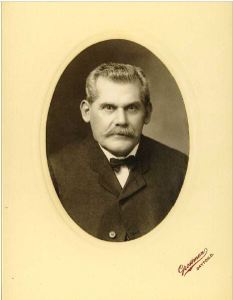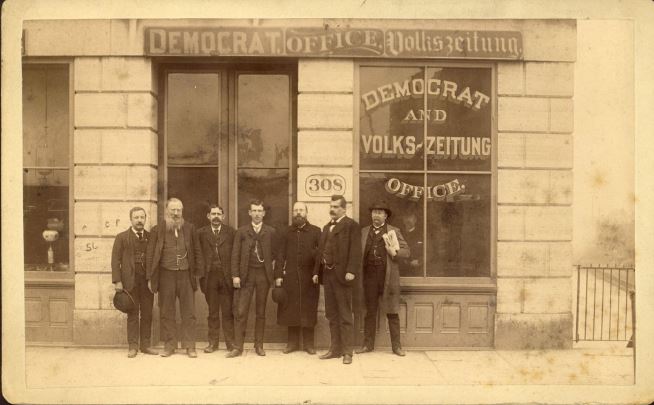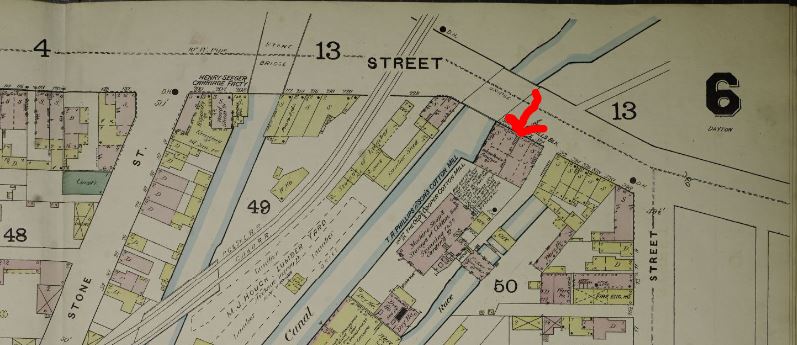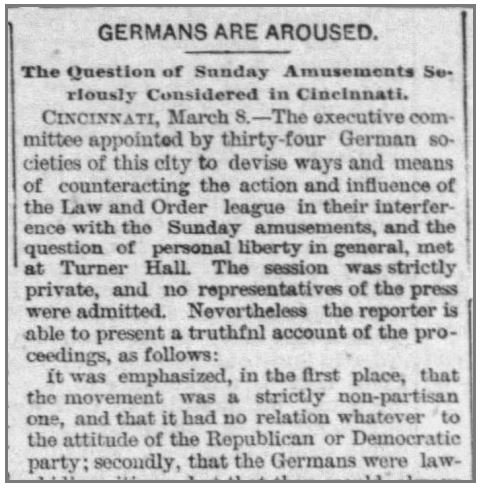[Continued from Otto and his German Language Newspaper: Part 1]
It was time for a new plan.
Otto canvassed the German neighborhoods. Promising a quality newspaper, he collected several hundred subscriptions before even publishing the first issue. Otto partnered with Charles Schenk, an old friend from Frankfort that arrived in Dayton a couple of years earlier. They set up shop at the Christian Publishing building at Sixth & Main in downtown Dayton. And with a used printing press and German fortitude, in Otto’s words, “on the first of September 1876, at five o’clock in the morning, Dayton saw its first Daily German Newspaper, and it really made a favorable impression on our German neighbors.” He named the newspaper the Dayton Anzeiger (“Advertiser”).

(photo credit: Moosbrugger Family Archives)
Historical records show that there were actually daily German language newspapers founded before Otto’s Dayton Anzeiger, but these were disorganized attempts; all were short-lived and most not lasting even a month in publication. Still, I feel confident Otto believed his claim to be the first, as the other newspapers failed long before and were likely no longer in anyone’s recent memory.
According to Gottfried Paasche in his paper America, Germany, and the Daytoner Volkszeitung, the size of the German language press correlated roughly with the size of German immigration. German language newspapers served a transitional function for the men and women beginning a new life and generally, it was only the first-generation immigrants that read it. A newspaper’s success depended on two things – how well it could keep German Americans informed and interested in German culture and how well it could inform them about life in the United States.
A typical German language newspaper of that time consisted of only four printed pages. The front page held news and advertisements. The reverse side had editorials of international, national, and local news. The third page shared characteristics with European newspapers, with poems, an installment of a novel, some articles giving background information on famous men, or descriptions of faraway places. The fourth page had more local news in the form of legal and social notices.

L-R: Angelo Moosbrugger, George Neder, Kuno Moosbrugger, Unknown, Ed Neder, Otto Moosbrugger, Unknown
(photo credit: Moosbrugger Family Archives)
Later when the long running Daytoner Volks-Zeitung (“People’s Newspaper”), changed to a daily publishing schedule, it was apparent that the Dayton German-American community couldn’t support both newspapers. In 1882, Otto partnered with editor George Neder to combine the two publications. They form The German Newspaper Company with George Neder as President and Otto as Secretary/Treasurer. Two of Otto’s brothers, Angelo and Kuno, took on roles, as well as George Neder’s son, Max. They moved their operations from 308 Fourth Street and headquartered at the Osceola Mill Building at 310 East Fifth Street. Today the Osceola Mills Block is the parking lot for Thai 9 and Jay’s Seafood in the Oregon District.

While Otto was working to make his name in media, he and Wilhelmina bought a cottage for two thousand dollars at 15 Buckeye Street, across the street where they were renting. It was here they raised their eight children. This home is now gone as well, with that northern side of the street replaced by US 35.
Adolph Otto Moosbrugger and Wilhelmina Föhrenbach are my husband’s great grandparents on his maternal side. We’re honored that they are part of our history and we can share their story.
And we think that “Smoky Love in the Mahlberg Cigar Factory” would make a great romance novel.
Sources:
- Moosbrugger, Adoph Otto. Personal Life History of Adoph Otto Moosbrugger. Handwritten Journal, 1909
- Orear, Linn. Survey of the Germans of Dayton 1830 – 1900; their cultural and economic role. Thesis. Miami University, 1961
- Paasche, Gottfried. America, Germany, and the Daytoner Volkszeitung 1880-1900. Thesis. Miami University, 1961
- Rattermann, H. A., and Elfe Vallaster-Dona. German Pioneers of Montgomery County, Ohio: Early Pioneer Life in Dayton, Miamisburg, Germantown. Published for Clearfield Company by Genealogical Publishing Company, 2014
- Tolzmann, Don Heinrich, et al. German Immigration to America: the First Wave. Heritage Books, 2007
- Wittke, Carl Frederick. The German-Language Press in America. Literary Licensing, 2000



